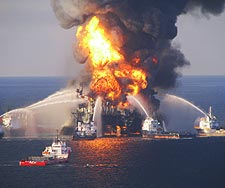
By Alanna Brown, LuxEco Editorial Assistant
On April 20, 2010, the oil rig Deepwater Horizon had a dire malfunction. Both its manual and emergency blowout preventers failed to deploy when the worst-case scenario became a reality. An oil rig blowout has the potential to occur when some combination of mud, oil, natural gas, and water erupt from the well, surge up the drill pipe, and ignite at the surface, exploding into an inferno.
According to the Associated Press, blowout preventers, or BOPs, have had infamous rates of failure. They write, “Cutoff valves…have repeatedly broken down at other wells in the years since federal regulators weakened testing requirements.” As many as 14 oil rig malfunctions in the past 5 years have been attributed to a faulty BOP, and its general reliability has been in question for over a decade. The device is simply and frighteningly a 640,000 pound steel plate fixed atop the well mouth, using up to 1 million pounds of force to block violent emissions. But it seems the explosive pressure pushing from beneath too often finds its way through.
So if the failure-rate of this mechanism is fairly common knowledge within the drilling industry, who’s to blame for the Deepwater Horizon catastrophe? Eleven workers were killed, our Gulf is swamped with millions of gallons of oil, and, with 5,000 more barrels of it gushing from the disaster site daily, our beaches are being contaminated as well. Naturally, no one wants to accept fault. But it’s unlikely that any one party could be held fully responsible anyway, as there are various companies, agencies, and interests involved. Pinpointing fault would be hard to do with such a dispersal of liability. For instance, BP (British Petroleum) owned the Deepwater Horizon operation, however the platform had been leased from Transocean, and Halliburton was hired to do the actual drilling. On top of that you’ve got your major government agency, the MMS (Minerals Management Service—a division of the Interior Department), which is responsible for government safety regulation over drilling on the Outer Continental Shelf.
Beginning with fundamental understanding of drilling oil versus Mother Nature, we have been at a practice that grossly misjudged its inherent danger. Disaster was only a matter of time. Because when you think about it logically, a steel pipe strung down through miles of ocean and then further submerged 18,000 feet below the sea floor, the conditions are formidable to say the least. Robert Bea, an engineering professor of the University of California, Berkeley who has also worked as an engineer on offshore drilling operations, said in an interview, “This is a pretty frigging complex system….So it has many potential weak points. Just as Katrina’s storm surge found weaknesses in those piles of dirt—the levees—gas likes to find weaknesses in anything connected to that source.” Bea found, in a study of 600 major equipment failures in offshore drilling structures, that 80% of errors can be likened to “human and organizational factors” while 50% of those derive from flaws in the engineering design. If these hazards were known beforehand, it appears there was an oversight at the executive level of BP or one of the affiliated companies; or simply, they knew and were willing to take the risk.
As for the government’s hand in all this, an article in Yale Environment 360 says, “Since the 1980s the MMS has routinely granted a blanket exemption from doing a comprehensive environmental impact statement to individual drilling operations.” The MMS again abused this authority last year by granting a “categorical exclusion” to the Deepwater Horizon lease. The reason for this exemption appears to be several misleading analyses based on checklist-type safety measures and daily environmental compliance. However, a catastrophe like this one is not a daily event, thus the likelihood and subsequent damage of an oil spill were majorly downplayed; the cataclysmic-level consequences hardly weighed.
Regardless of who’s to blame, the lack of a worst-case analysis means BP, the government, and other parties involved are far under-prepared for how to stop the wrecked pipe from gushing oil, and how to handle the cleanup.














People like fashion for their style statement to look different and special. Fashion varies with person to person, like, trendy, causal, hip hop, urban and designer. People spend thousand of dollars to feel luxury in wearing.